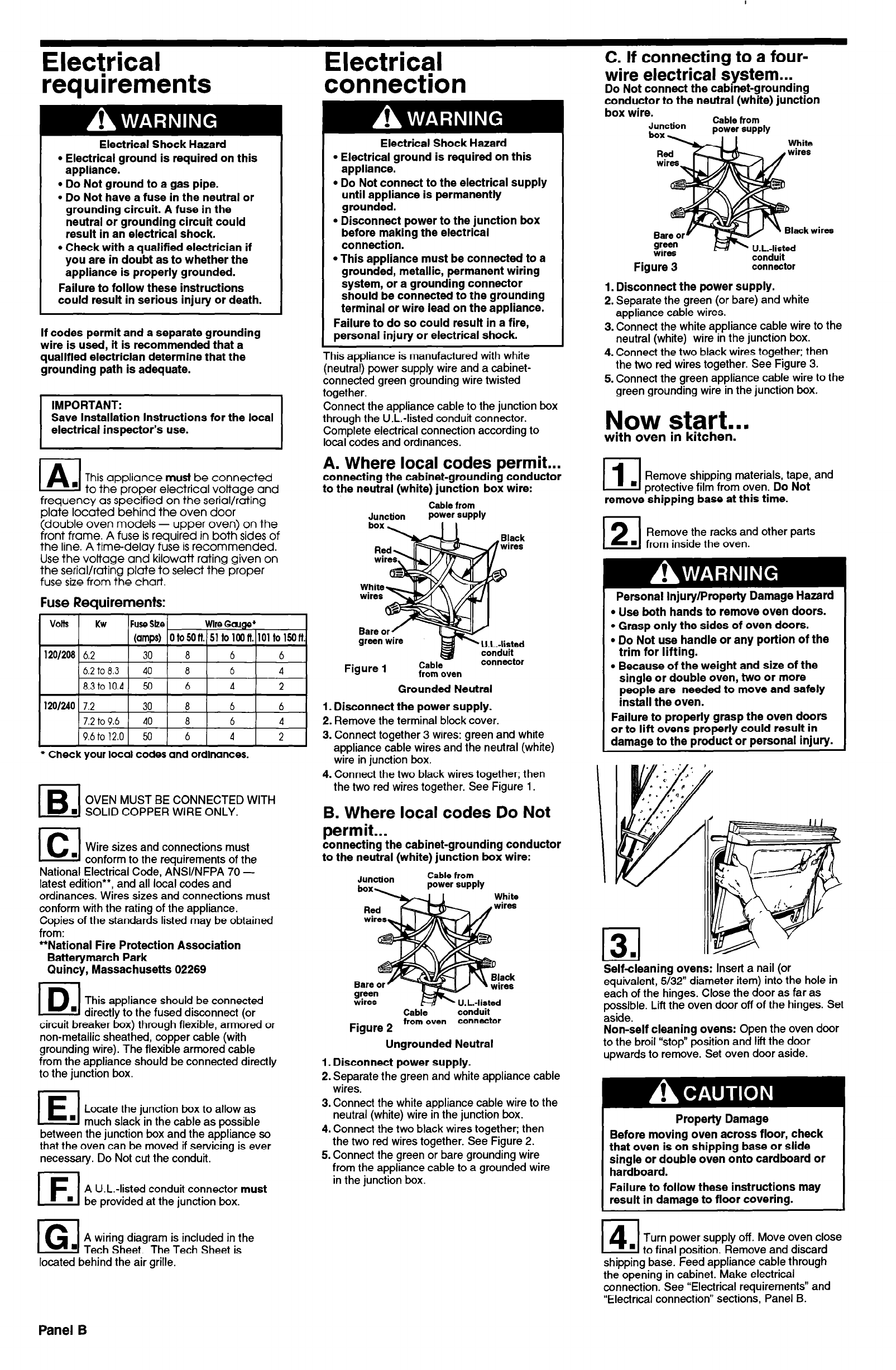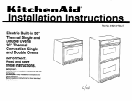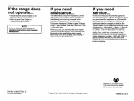
Electrical
Electrical
requirements
connection
Electrical Shock Hazard
l
Electrical ground is required on this
appliance.
l
Do Not ground to a gas pipe.
l
Do Not have a fuse in the neutral or
grounding circuit. A fuse in the
neutral or grounding circuit could
result in an electrical shock.
l
Check with a qualified electrician if
you are in doubt as to whether the
appliance is properly grounded.
Failure to follow these instructions
could result in serious injury or death.
If codes permit and a separate grounding
wire is used, it is recommended that a
qualified electrician determine that the
grounding path is adequate.
IMPORTANT:
Save Installation Instructions for the local
electrical inspector’s use.
Electrical Shock Hazard
l
Electrical ground is required on this
appliance.
l
Do Not connect to the electrical supply
until appliance is permanently
grounded.
l
Disconnect power to the junction box
before making the electrical
connection.
l
This appliance must be connected to a
grounded, metallic, permanent wiring
system, or a grounding connector
should be connected to the grounding
terminal or wire lead on the appliance.
Failure to do so could result in a fire,
personal injury or electrical shock.
This appliance is manufactured with white
(neutral) power supply wire and a cabinet-
connected green grounding wire twisted
together.
Connect the appliance cable to the junction box
through the U.L.-listed conduit connector.
Complete electrical connection according to
local codes and ordinances.
This appliance must be connected
to the proper electrical voltage and
frequency as specified on the serial/rating
plate located behind the oven door
(double oven models - upper oven) on the
front frame.
A
fuse is required in both sides of
the line.
A
time-delay fuse is recommended.
Use the voltage and kilowatt rating given on
the serial/rating plate to select the proper
fuse size from the chart.
A. Where local codes permit...
connecting the cabinet-grounding conductor
to the neutral (white) junction box wire:
Cable from
Fuse Requirements:
120/208 6.2
30 a 6
6
conduit
connector
6.2 to 8x3
40 a 6
4
Figure 1
Cable
from oven
[I l.Di;nnect~~~~~ . _ ,- .
2. Remove the terminal block cover.
3. Connect together 3 wires: green and white
1
+ Check your
local
codes and ordinances.
1
appliance cable wires and the neutral (whrte)
wire in junction box.
IBI
OVEN MUST BE CONNECTED WITH
n SOLID COPPER WIRE ONLY.
4. Connect the two black wires together; then
the two
red wires together.
See Figure 1.
B. Where local codes Do Not
El
permit...
Wire sizes and connections must
connecting the cabinet-grounding conductor
. conform to the requirements of the
National Electrical Code, ANSI/NFPA 70 -
latest edition** and all local codes and
ordinances. Wires sizes and connections must
conform with the rating of the appliance.
Copies of the standards listed may be obtained
from:
to the neutral (white) junction box wire:
Cable from
“National Fire Protection Association
Batterymarch Park
Quincy, Massachusetts 02269
IDI
.
This appliance should be connected
directly to the fused disconnect (or
circuit breaker box) through flexible, armored or
non-metallic sheathed, copper cable (with
grounding wire). The flexible armored cable
from the appliance should be connected directly
to the junction box.
Cable
conduit
Figure 2
from oven
connector
Ungrounded Neutral
1. Disconnect power supply.
2. Separate the green and white appliance cable
wires.
E-I
.
Locate the junction box to allow as
much slack in the cable as possible
between the junction box and the appliance so
that the oven can be moved if servicing is ever
necessary. Do Not cut the conduit.
El
A U.L.-listed conduit connector
must
. be provided at the junction box.
IGI
A wiring diagram is included in the
n
Tech Sheet. The Tech Sheet is
located behind the air grille.
3. Connect the white appliance cable wire to the
neutral (white) wire in the junction box.
4. Connect the two black wires together; then
the two red wires together. See Figure 2.
5. Connect the green or bare grounding wire
from the appliance cable to a grounded wire
in the junction box.
C. If connecting to a four-
wire electrical system...
Do Not connect the cabinet-grounding
conductor to the neutral (white) junction
box
iom
White
wlree
conduit
Figure 3
connector
1. Disconnect the power supply.
2. Separate the green (or bare) and white
appliance cable wires.
3. Connect the white appliance cable wire to the
neutral (white) wire in the junction box.
4. Connect the two black wires together; then
the two red wires together. See Figure 3.
5. Connect the green appliance cable wire to the
green grounding wire in the junction box.
Now start...
with oven in kitchen.
Remove shipping materials, tape, and
protective film from oven.
Do Not
remove’shipping base at this time.
121
Remove the racks and other parts
. from inside the oven.
l
Use both hands to remove oven doors.
l
Grasp only the sides of oven doors.
l
Do Not use handle or any portion of the
trim for lifting.
l
Because of the weight and size of the
single or double oven, two or more
people are needed to move and safely
install the oven.
Failure to properly grasp the oven doors
or to lift ovens properly could result in
damage to the product or personal injury.
Selfcleaning ovens:
Insert a nail (or
equivalent, 5/32” diameter item) into the hole in
each of the hinges. Close the door as far as
possible. Lift the oven door off of the hinges. Set
aside.
Non-self cleaning ovens:
Open the oven door
to the broil “stop” position and lift the door
upwards to remove. Set oven door aside.
Property Damage
Before moving oven across floor, check
that oven is on shipping base or slide
single or double oven onto cardboard or
hardboard.
Failure to follow these instructions may
result in damage to floor covering.
141
Turn power supply off. Move oven close
. to final position. Remove and discard
shipping base. Feed appliance cable through
the opening in cabinet. Make electrical
connection. See “Electrical requirements” and
“Electrical connection” sections, Panel B.
Panel B







